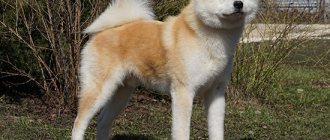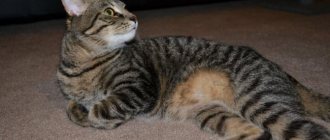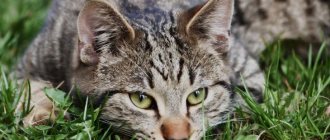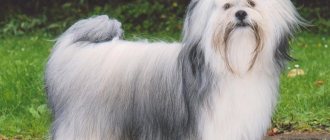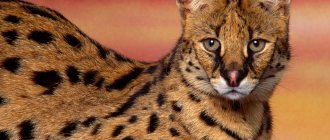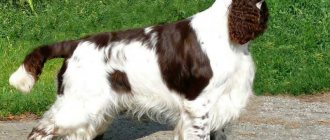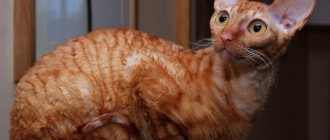- Posted by Olga Petrova
- Date: June 15, 2018
A predatory look, a proud posture and an affectionate character. This is all Chausie - an elite breed of cat that not everyone can afford. She is one of the five most expensive cat breeds.
- 2 Appearance
2.1 Photo gallery: cat breeds for breeding Chausie - 2.2 Photo gallery: acceptable colors of Chausie
- 6.1 Power
- 7.1 Castration and sterilization of Chausie
History of the origin of the Chausie cat breed
The Chausie, or Hausie, is a relatively young breed of cat, even though some scientists date the appearance of their ancestors to the times of Ancient Egypt.
On the frescoes that decorated the palaces, you can find images of cats that were very similar to individuals of this breed. They were treated with respect, as cats were considered sacred animals in Egypt.
Experts suggest that these cute creatures came from crossing a wild jungle cat and a domestic cat. The habitat of the wild ancestors of the Chausie was quite extensive: from South to Central Asia. A small number of them were also common in Africa.
On the frescoes of Ancient Egypt you can find images of cats that look very similar to chausie
For a long time, no one knew about chausie. Only in the late 60s of the 20th century did one American tourist draw attention to unusual cats walking along the streets of Egypt. It took a lot of time to study the Chausie and get healthy offspring. But attempts to develop a new breed were ultimately successful, and in 2003 the Chausie was recognized as an independent breed. The standard was developed 8 years earlier, in 1995, by the international cat association TICA.
Unfortunately, it is very difficult to find such a cat in Russia. The largest number of chausie are concentrated in the USA and France, but there are still very few of them.
Chausie is a cat whose photo will not leave anyone indifferent
Cats of this breed seem to be specially created to pose in front of camera lenses. There is so much grace in their movements! How expressive are their intelligent eyes! Anyone who has ever seen a photo of a Chausie will definitely want to meet this animal in person, but getting this cat is not so easy.
Even photographing chausie at exhibitions is not always allowed. Magazines negotiate with nurseries or owners about photo sessions, giving away a decent amount of money.
Appearance
The more similar a Chausie cat is to its ancestor, the jungle cat, the better. But since artificial long-term selection involved crossings with other breeds, some external differences from what their wild ancestor looks like are allowed. Over the course of many years of studying this breed, it was determined that in order to obtain healthy kittens and the appearance characteristic of this breed, the Chausie can only be crossed with Abyssinian or regular shorthair cats.
All kittens born are marked according to what percentage of wild jungle cat blood they contain. Accordingly, the following generations of chausie are distinguished:
- F1 is a direct descendant of a male Chausie and a cat, that is, 50% of wild blood flows in him and in appearance such cats are very similar to jungle cats, they have the appropriate temperament and size;
Chausie F1 contains 50% of the blood of a wild cat, so its character and appearance are closer to a predator than to a domestic pet.
- F2 is a descendant of Chausie F1, the share of the blood of the wild ancestor is 25%, the average Chausie has a more loyal temperament, but its weight is 10 kilograms or more.
- F3 is a descendant of Chausie F2, the wild jungle cat has 12.5% blood, it is an animal with the temperament and size of a domestic cat, but with an appearance that is close to the jungle cat.
- F4 and F5 - the proportion of wild blood is less than 12.5%, the cats are fully socialized, have a standard size and build.
Photo gallery: cat breeds for breeding Chausie
Often a simple short-haired cat is chosen as a partner for a Chausie.
From her wild ancestor, Chausie inherited a strong physique and a predatory look
Most often, the Abyssinian cat is chosen as a partner for the Chausie.
Chausie is a fairly large cat, but its weight depends on which generation it belongs to. The body weight of an adult animal can vary from 4 to 15 kg . Accordingly, the closer an animal is to its wild ancestor, the more it weighs. Cats are bigger than cats. The remaining characteristics do not depend on the chausie class:
- the head is elongated, wedge-shaped, medium in size, when compared with the proportions of the body it seems small, the frontal bone is wide, the cheeks are taut, the nose is straight and wide;
- the eyes are almond-shaped, slightly slanted, the color can be yellow, amber or green;
- the ears are wide and erect, set high, it is desirable to have tassels at the tips, characteristic of many wild breeds, which must certainly be black; if the pet is classified as F1, then on the back of the ears there should be a pattern of spots, which are also called the “deceptive eye”;
- the neck is short, stocky;
- the body is large, muscular, but at the same time the chausie is very elegant and graceful, the chest is wide, the shoulders and pelvic bone are narrow, the back is straight and quite wide, the height at the withers is about 40 cm;
- the paws are strong, large, the front ones are noticeably shorter than the hind ones;
- the tail is long, can reach 3/4 of the body length, there is a black tassel at the end;
- the coat is short, close to the body, shiny;
- The colors allowed are black, brown ticking and black tabby, new colors of kittens are constantly appearing, but only Chausies of these three colors can participate in exhibitions.
Photo gallery: acceptable colors of Chausie
The interesting pattern on tabby cats is very attractive to lovers of these animals.
Chausie with brown ticking color is very similar to Abyssinian cats
Chausie's hair should not be monochromatic
Mr. Cat recommends: why real Chausie is so rare
Creating a new breed by crossing with a wild cat is extremely difficult due to the low birth rate of the first generations and many other problems. But the Chausies turned out to be simpler in this matter than the Bengals. Biologists have noted that Jungle Cat has many character traits that are quite suitable for living next to a person, despite many rumors and myths about the “bloodthirstiness” of hybrids. And fertility among the descendants of the first Houses developed much faster. Usually, sufficient fertility of males can be recorded only by the sixth generation of hybrid animals, as was the case with the Bengal breed.
More than many other cats, the Jungle Cat was initially suitable for domestication. He is smart and funny, not aggressive or timid, and gets along well with domestic females. And in physical terms, compatibility is quite high, despite the larger size. The female’s gestational age is the same, the number of kittens in the litter, and the average weight of the newborn are also identical. But the Houses are in danger of extinction. And if people try to buy them as pets, this danger will increase even more.
Wild cat house
The goal of the Chausie program is to develop a domestic breed that will retain the type, color and pattern of the Jungle Cat. To be a Chausie, a female must be descended from at least one House and be similar to him, but for socialization and fertility, have ancestors primarily of domestic cats. Therefore, the first hybrids were not true purebred animals. Breeders had to work hard to get true representatives of the breed.
The cats of the first generation were completely sterile, while the cats of the second generation sometimes gave birth to one litter. If kittens were born more often, conception rates decreased, and one baby could be born.
The success was that the third generation produced a full-fledged male. Tasurt Naabhi or Naabi is the first cat capable of producing stable offspring, a hydride with 12.5 percent wild blood. His name appears in almost all pedigrees of today's Chausie.
The percentage of wild blood is the key, not the number of generations per se. If wild ancestors are found on both sides of the family tree, it may take more generations to achieve male fertility. On the one hand, breeders must select a large number of domestic females, on the other hand, at some point not to lose the traits of a true Jungle Cat. It becomes more difficult to maintain sufficiently healthy genetic diversity in the breed's gene pool. At the same time, it is necessary to move further in order to move to SBT status - to become a purebred and completely domestic animal.
In Russia there are practically no Chausie SBTs, only hybrids of the first, second and third generations. They are obtained by crossing a House with an Abyssinian, American Shorthair or Siamese cat. All true kennels and purebred, already fully domesticated purebred animals are concentrated in the United States of America.
Ideally, Chausie is a brown ticked tabby, solid black or black gray ticked tabby color. However, the breed is relatively young, and non-standard specimens appear frequently. It can be other colors, such as chocolate, or with a pattern on the wool. These kittens will not be show specimens, but they retain all other characteristics of the breed and their wonderful, cheerful character. They will make excellent pets.
Chausie character and behavior
Chausies, despite their wild roots, have a friendly character. They are very sociable and become very attached to their owner. At the same time, they will not get bored with constant meowing and sitting on your lap. Chausies are very smart and delicate.
Chausie becomes very attached to his owner
They do not tolerate loneliness well, so they require the constant presence of a person or other pets. They get along well with animals of their own size or larger, but small pets can become their prey.
Chausies get along very well with children. They are very active and love outdoor games that children play with them. Indifferent attitude towards outsiders. They are not afraid to go out and see who has visited their home, but they will not show their affection. It is important to note that the behavior of a Chausie largely depends on its upbringing. From early childhood, the pet must be taught that human hands and feet are not a toy, then the animal will not scratch or bite as an adult.
Wild roots have left their mark on the activity of the chausie - these are very active and curious animals. When buying this cat, you need to remember that it is unacceptable to keep representatives of the F1 and F2 classes in an apartment. A large space that can be explored without holding back their desire to run around is vital for them. Living in a private home is ideal for these cats.
Representatives of generations F3 and below can be kept in apartment conditions, but the owner must find time every day to communicate and play with the pet, and also regularly walk it on a leash. These cats are quite trainable and are able to follow some simple commands.
It is better to keep Chausie in a private house with access to the yard
The cleanliness of the chausie is also excellent. They often lick themselves for a long time, which saves the owner from endlessly cleaning the room from animal hair.
Purchasing a kitten
Fans of miniature cougars often wonder: how much does a Chausie cat cost? Cats of this breed are in second place among the most expensive cats in the world.
There are very few nurseries where you can buy Chausie. And this factor undoubtedly affects the cost of these cats. The price of kittens varies from two hundred to five hundred thousand rubles. Premium purebreds can cost one million rubles.
The primitive wild beauty of these cats is combined with a loving and devoted character, so the Chausie will become not just a pet for its owner, but the most faithful and reliable friend for many years.
What else to see:
Chausie diseases
In general, Chausies are in good health, but they have a shorter gastrointestinal tract than most domestic cats, so they are not allowed to eat plant foods.
Chausies also have an excellent appetite, which is more like gluttony, so the owner’s lack of control over the pet’s portion size can lead to obesity.
The rest of the recommendations regarding the health of the Chausie are the same as for other cat breeds:
- timely vaccination;
- measures aimed at preventing and getting rid of parasites;
- annual preventive examination by a veterinarian.
It is recommended to visit a veterinarian for a preventive examination at least once a year.
Chausies live quite a long time: their lifespan is about 15–20 years.
Care and maintenance
Chausie is a very active cat, so she needs private walks. She will literally ask to go outside, like a dog, when she gets tired of sitting within four walls. For walks you need to buy a leash.
In order to make the animal more comfortable, it is necessary to acquire toys. The collection should be replenished periodically, otherwise the homeschooler will start playing with curtains, a toothbrush and other things that seem funny to him.
Such short-haired representatives are not demanding in terms of care. They only need brushing with a soft brush once a week, daily brushing of teeth and ears, and occasional bathing. You can buy a massage glove that will help stimulate blood circulation and have a positive effect on the pupil’s appearance. By the way, these cats are water lovers, so they will only enjoy water treatments.
How to choose a kitten
Since Chausie is a very rare breed, the cost of kittens is very high: it can start from 100 thousand rubles. There is no ceiling on the price. There is information on the Internet that very wealthy people paid 1 million rubles for one Chausie kitten.
While preparing this material, I found an advertisement for the sale of a Chausie kitten for 30 thousand rubles. But still, I very much doubt that a kitten of this breed can cost so little. The peculiarities of breeding are unlikely to allow the price to be reduced so much. Most likely, a completely different breed is being passed off as a Chausie.
Buying a Chausie kitten is a very difficult undertaking. Since this breed is very small in number, the nurseries with these beauties can be counted on one hand. Breeding Chausies is very difficult, so buying kittens from private breeders is very risky. It is better to contact trusted nurseries.
It is better to buy a kitten when it reaches three months of age: it is at 3 months that the baby can be painlessly separated from its mother.
Externally, the small chausie has the same characteristic features as adult individuals: color, wedge-shaped muzzle, wide, high-set ears, black tip of the tail. The F1 kitten will be very large, its characteristic features are “deceptive eyes” (characteristic stripes and spots on the back of the ears) and the nature of a predator. The F4 kitten has the personality and size of a domestic cat.
Chausie kittens immediately have the color of an adult animal
When buying a kitten, you need to inspect it:
- The baby's belly should not be bloated;
- skin, ears and eyes must be clean;
- the coat is uniform, without bald spots;
- the kitten should be active and curious.
When purchasing a kitten, breeders must provide the following documents:
- contract of sale;
- kitten's metric or completed pedigree;
- veterinary passport with notes on vaccinations and deworming.
When choosing a pet, you should also decide on its gender. Cats are more active and playful, but at a certain period they begin to mark their territory, which, of course, may not please the owner. Kitties are more affectionate, but several times a year during the period of heat they begin to ask to fulfill their destiny: to become a mother. And since these cats are not at all easy to breed, this fact must be taken into account when purchasing an animal. It is also worth considering that some breeders note this feature in female Chausies: they often mark their territory just like cats.
Pros and cons of the Housie breed
| pros | Minuses |
|
|
Chausie is included in the ranking of the most expensive and exotic breeds.
This miniature copy of a wild cat will become a worthy friend for humans and will be able to find a common language with other animals. *Prices are as of October 2021.
How to care for your pet
Caring for the Chausie is not difficult at all. Since this cute cat is very clean, it is enough to comb her fur once a week with a massage brush, more to improve blood circulation than to remove dead hairs.
There are no restrictions regarding swimming - Chausies love to swim. There are often cases when they come to their owner’s bathroom while he is bathing and happily jump into the water with him.
Chausies love to swim
Despite the fact that most sources do not contain information on how often you can bathe a Chausie, I still do not recommend doing it more than once every 3 months. Like any cat, the skin of this breed is covered with a special fat, which, if washed off, can lead to problems with the skin.
You need to clean your pet's eyes and ears as needed. Teeth also need periodic examination and cleaning. It is enough to brush your chausie's teeth once a week to prevent the formation of tartar. Claw care will not be required if you have a scratching post, on which the fluffy beauty will regularly sharpen his claws.
With a scratching post, Chausie will be able to take care of his claws himself.
When it comes to toilet training with a Chausie, things are not that simple. The closer a kitten's generation is to its wild ancestor, the more difficult it is to teach it to relieve its needs in a specially designated place, but still this issue is not insoluble. With a certain patience and perseverance of the owner, after some time the Chausie begins to go to the litter box, which should be quite spacious, since this cat is quite large. You can choose any filler.
In my opinion, the best are clumping cat litters. They perfectly absorb odors, leave the cat's paws dry, and you can replace only part of the used litter, and not completely empty the entire contents of the tray.
Some owners even managed to train Chausie to go to the toilet.
Nutrition
As mentioned above, the gastrointestinal tract of the chausie has a peculiarity: it is not able to digest plant foods. The diet of these cats should consist of the following products:
- raw meat of beef, rabbit, poultry;
Chausie diet should be meat
- raw fish;
- raw quail eggs.
The bowl should always contain clean and fresh water, passed through a filter or boiled.
The Chausie's diet is also different from how other cats are fed. If the usual recommendation for feeding kittens is 6 meals a day until they reach 3 months, 4 times at the age of six months and 2 times at 9 months, then it is not recommended to feed Chausie at a young age more than twice a day. And when the animal reaches one year of age, the number of meals should be generally reduced to 1 time per day. At the same age, you need to start practicing a fasting day once a week. The amount of food that should enter the animal’s body should not exceed 5% of its body weight.
Breeders recommend feeding your pet super-premium industrial food. The food must be suitable for cats with sensitive digestion.
Care for claws, teeth, eyes, ears
Caring for the ears, teeth and eyes of the Chausie is not too different from caring for other domestic cats:
- The ears are cleaned every five to six days with special drops for cleaning the ears. Place a few drops into your ear and gently massage the base of the ear for 2-3 minutes.
- The eyes should be cleaned daily with a cloth soaked in warm water. You need to wipe in the direction from the inner corner to the outer.
- Teeth are cleaned using a silicone toothbrush and toothpaste for cats. The joints of the teeth and the area near the gums are most thoroughly cleaned.
- A simple scratching post will not work for Chausie's claws: they will need a wooden log. Nails need to be trimmed as they grow - buy a nail clipper for this. The claw is cut slightly at an angle, so that the cut from the front resembles the tip of a nail and does not affect the pink sensitive part of the claw. If the claw bleeds after trimming, treat the wound with peroxide.
Chausie claws are powerful and long, so anti-scratch treatments are ineffective for them.
Breeding Features
When planning to start breeding Chausie, you need to be prepared for many difficulties. Firstly, to get kittens with the appearance of a true chausie, you need to organize a mating with a jungle cat, which is not so easy to find. Even the second generation of kittens will already be deprived of their unique appearance, let alone generations F3 and beyond.
Breeding Chausie is very difficult
Secondly, if it is possible to obtain offspring possessing all the characteristics of the breed, then most of the males will be incapable of procreation. It is these features that primarily determine the high price of these cats.
It has already been said above that mating can only be carried out with Abyssinian or ordinary short-haired cats.
If pregnancy does occur, then it passes without any special features and lasts from 63 to 70 days from the moment of conception. Signs of pregnancy are:
- poor appetite that appears within 10 days after mating;
- lethargy;
- increase and intensification of nipple pigmentation;
- enlarged belly at 6 weeks.
Mating is planned no earlier than the end of the first or second estrus in animals at least 1 year old.
Castration and sterilization of Chausie
Often, when purchasing an animal, breeders immediately discuss the issue of procreation with buyers. If a kitten is not purchased for breeding, then the contract usually states that the owners are obliged to castrate or sterilize the animal. Such individuals are cheaper than those for which mating is allowed.
If further procreation is not planned, then the animal must be castrated. Even if a cat is sterile from birth, this will not be an obstacle for him to mark his territory and loudly ask for a girlfriend. Castration is carried out when the baby teeth change, that is, at about 8 months. It is best to sterilize a cat between 9 and 12 months of age.
Experts do not note any peculiarities in carrying out these operations.
Of course, I would like to immediately make a reservation that attributing castration to cats and sterilization to cats is wrong. In fact, these operations can be performed on both sexes. Castration is the procedure for removing the sex glands and organs responsible for procreation (testes in males, ovaries in females). After this, the production of sex hormones stops. Sterilization is an operation to ligate or remove lobes of the seminal ducts in cats and create obstruction of the fallopian tubes in the cat. But there is an unspoken agreement to use these terms to mean the termination of the ability to reproduce in males and females.
Castration and sterilization
If you do not set yourself the goal of breeding the breed, then it is necessary to undergo a sterilization operation. In many countries, this operation is a requirement for keeping non-breeding pets. This has been proven time and again to be the most humane way to treat your pets. Moreover, this operation must also be carried out with sterile animals.
The best time for surgery: before puberty. This usually corresponds to nine months of age.
Video
* We invite you to watch a video about the Chausie . In fact, in front of you is a playlist in which you can select and watch any of 20 videos about a given cat breed by simply clicking on the button in the upper right corner of the window. In addition, the material contains quite a lot of photos. By looking at them you can find out what Chausie looks like.
Rate the material!
[Total votes: 0 Average: 0]
Today there is a wide variety of cat breeds. Chausie cats as the most exclusive and unusual. This breed was developed by crossing a domesticated Abyssinian cat and a jungle cat. As a result of crossing a rare breed with a wild cat, the result was a cat of incredible beauty and grace. Representatives of this breed are among the five most expensive cats in the world. They are believed to have an incredibly graceful, attractive, aristocratic appearance and a combination of incredible genes.
Diseases and health problems
By nature, cats are endowed with strong immunity and good health. They are not too susceptible to various pathologies. However, it is worth considering that, like all other animals, chausies are susceptible to infection with helminthic infestations. Representatives of this breed have a rather weak digestive system, and therefore they can get sick if they are not fed properly.
Interesting fact: Insufficient physical activity can cause obesity. Therefore, it is very important to follow the regimen and frequency of meals, as well as move enough.
After bathing and water procedures, cats need to be dried in a warm room without drafts, as they are prone to colds. Colds are manifested by discharge from the eyes, sneezing, watery eyes, lethargy, and refusal to eat and drink.
Everyone knows that chausies have an excellent appetite. Once you leave the cats alone with food, he will certainly enjoy plenty. The owner of these cats must understand how important it is to regularly visit the veterinarian and get all the necessary vaccinations.
Be sure to comb out six. Cats tend to lick themselves. If the fur is not combed out, it ends up in the stomach. Indigestion develops. In severe cases, the animal may even die.
Once every one and a half to two years, it is recommended to visit a specialist to remove tartar. If this is not done, there is a risk of developing gingivitis, tooth loss, and inflammatory processes in the oral cavity.
Exterior
The goal of the breeding program is to achieve a look that replicates the appearance of a jungle cat. The stronger the similarity, the more successful the offspring. The Chausie cat gives the impression of a strong, robust, but agile animal without a hint of bulkiness.
The head is wedge-shaped, the cheekbones are high and sharp, the muzzle is elongated. The chin is strong. The nose is convex, wide, the nostrils are open;
The ears are set high, sticking out vertically, without falling apart to the sides. The canvas is quite wide and noticeably longer than that of ordinary cats. A rounded tip and tassels are desirable;
The eyes are small to medium-sized, set slightly obliquely. The lower eyelid is more rounded than the upper. The desired color is golden, yellow, nutty, with a green tint allowed. Blue iris is prohibited;
The body is long, the chest is deep. The limbs are long, angular, with a rise in the croup. The muscles are noticeable, but not overloaded. The paws are strong and oval.
The tail tapers to the tip, is of medium length, thick at the base, very mobile. Creases are not allowed.
The coat of the Chausie cat is short, thick, with a soft, dense undercoat. The spine is elastic and rough. Agouti color, that is, each hair is colored in rings, like a traffic controller’s baton. The exception is black.
There should be at least two rings (ticking) in length, the contrast between the base shade and the ring is obvious. The prefix “tabby” means the presence of stripes, a scattering of spots, and necklaces. As a rule, this is the lower part of the paws, tail, neck, forehead. For chausie, a “ghostly”, barely visible pattern is acceptable.
The standard describes 6 colors:
- black solid;
- a black grizzly looks like an anthracite cat has turned gray or is covered in frost;
- black grizzly tabby – previous version with stripes;
- black ticked tabby - wild Abyssinian color, black rings, with stripes;
- brown ticked tabby – dark brown rings with stripes;
- silver ticked - gray coat with almost white rings.
Since the breed is at the very beginning of its formation, the standard is constantly being refined. When choosing a kitten, it is better to rely on the reputation of the breeder and expert opinion regarding the parents of the litter. If we are talking about the first generation of hybrids, the nursery must have permission to keep wild animals.
Color
The standard provides 3 main colors:
- plain black (no markings);
- ticked black tabby (the undercoat is golden with a scarlet tint, there are points on the inside of the paws and tail, there is a light rim around the eyes, and the same on the chin);
- gray-black ticked tabby (ticked stripes on the guard hair - 2-3 pieces, the tips are always dark).
The photo shows a Coca of the Chausie (Housey) breed in the main colors
Nutrition
Not the easiest question in keeping a mini cougar. They have an insatiable appetite and a sensitive digestive system. For example, they may react poorly to grains, which are included in many commercial foods. Pork is a strictly prohibited product. Therefore, special attention should be paid to diet.
You can feed him natural meat, only dietary meat. This can be raw beef, various fish and rabbit meat. You can give chicken, quail, and raw quail eggs. Be prepared that he will consume large quantities of animal food.
In addition, you must add the necessary carbohydrates and microelements to your diet. Daily feeding should be done no more than twice before a year, and after a year - once a day. They even recommend arranging fasting days. Still, he moves much less at home than his wild pedigree requires. It is also recommended to feed Chausie with premium food (no grains!) or holistic food.
Holistic ("holistic" food) is a new generation of food that is made from products intended for people. Fresh meat and fish, fresh fruits and vegetables instead of processed foods and fillers. The composition is absolutely natural, without preservatives, dyes, artificial additives and fragrances.
Cats primarily eat animal meat. They perfectly digest all the nutritional components of meat, but they do not cope so easily with carbohydrates. However, they are necessary in reasonable quantities. The optimal carbohydrates for pussy are boiled brown rice and oatmeal.
Tapioca (a grainy, starchy product made from the roots of cassava, a South American spurge), sweet potatoes, or fresh fruits and vegetables are also good options. The menu should only contain no more than 10% carbohydrates.
Holistic food takes these proportions into account, adding dried fruits and vegetables as prebiotics, as well as desirable minerals, omega acids and vitamins - categories of substances necessary for normal digestion. Everything that makes a cat healthy, its fur beautiful, and its mood cheerful.
You will have to read the labels carefully. If a food contains foods that are unknown to you, or you cannot identify, or they do not fit into the categories listed above, the food is incorrectly labeled as holistic.
Attention! Your pet's water should be filtered or boiled. Raw water is contraindicated.
Education and physical activity
Chausies are smart cats with high intelligence and good memory. If you show a little patience and perseverance, you can teach them not only the rules of behavior in the house, but also simple commands. The main thing is to praise the Hausi more often for his successes and do not forget to reward him with a treat.
To prevent the cat from getting bored while waiting for its owners, it is provided with a variety of toys, balls and a sports corner. And to maintain good physical shape, Chausie needs regular walks.
Conclusions about the breed
global $ads_google;
//data-ad-slot=”2475549904″ $ads_google = empty($ads_google) ? false : true; ?> if ($ads_google == false) {?> $ads_google = true; ?> } ?> So, who should own a chausie and why?
- active family with other pets, but preferably without small children. They are kind, affectionate and obedient, but from time to time they are unpredictable and are able to show their ambition.
- owners of private houses. Chausies are excellent guards and hunters. Of course, they are not as good as dogs, but a mouse or an uninvited guest will definitely not get into your home.
- those who are not ready to spend significant sums of money on care and treatment of diseases. Only a few things (meat table, walks, bathing and socializing with people) are enough to make your pet happy.





